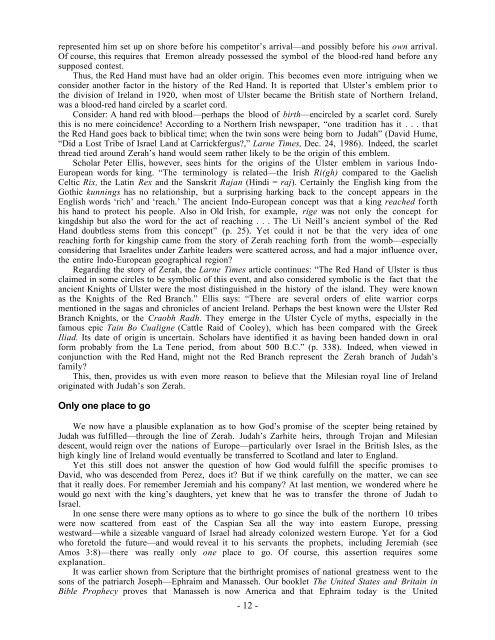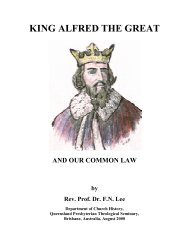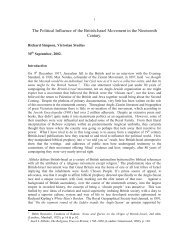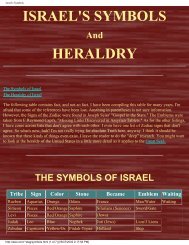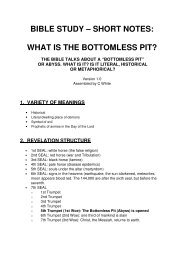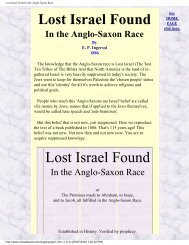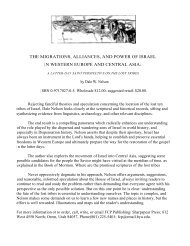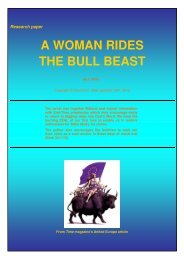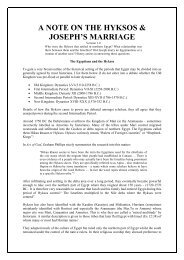The Throne of Britain: Its Biblical Origin and Future - Origin of Nations
The Throne of Britain: Its Biblical Origin and Future - Origin of Nations
The Throne of Britain: Its Biblical Origin and Future - Origin of Nations
Create successful ePaper yourself
Turn your PDF publications into a flip-book with our unique Google optimized e-Paper software.
epresented him set up on shore before his competitor’s arrival—<strong>and</strong> possibly before his own arrival.<br />
Of course, this requires that Eremon already possessed the symbol <strong>of</strong> the blood-red h<strong>and</strong> before any<br />
supposed contest.<br />
Thus, the Red H<strong>and</strong> must have had an older origin. This becomes even more intriguing when we<br />
consider another factor in the history <strong>of</strong> the Red H<strong>and</strong>. It is reported that Ulster’s emblem prior to<br />
the division <strong>of</strong> Irel<strong>and</strong> in 1920, when most <strong>of</strong> Ulster became the British state <strong>of</strong> Northern Irel<strong>and</strong>,<br />
was a blood-red h<strong>and</strong> circled by a scarlet cord.<br />
Consider: A h<strong>and</strong> red with blood—perhaps the blood <strong>of</strong> birth—encircled by a scarlet cord. Surely<br />
this is no mere coincidence! According to a Northern Irish newspaper, “one tradition has it . . . that<br />
the Red H<strong>and</strong> goes back to biblical time; when the twin sons were being born to Judah” (David Hume,<br />
“Did a Lost Tribe <strong>of</strong> Israel L<strong>and</strong> at Carrickfergus,” Larne Times, Dec. 24, 1986). Indeed, the scarlet<br />
thread tied around Zerah’s h<strong>and</strong> would seem rather likely to be the origin <strong>of</strong> this emblem.<br />
Scholar Peter Ellis, however, sees hints for the origins <strong>of</strong> the Ulster emblem in various Indo-<br />
European words for king. “<strong>The</strong> terminology is related—the Irish Ri(gh) compared to the Gaelish<br />
Celtic Rix, the Latin Rex <strong>and</strong> the Sanskrit Rajan (Hindi = raj). Certainly the English king from the<br />
Gothic kunnings has no relationship, but a surprising harking back to the concept appears in the<br />
English words ‘rich’ <strong>and</strong> ‘reach.’ <strong>The</strong> ancient Indo-European concept was that a king reached forth<br />
his h<strong>and</strong> to protect his people. Also in Old Irish, for example, rige was not only the concept for<br />
kingdship but also the word for the act <strong>of</strong> reaching . . . <strong>The</strong> Ui Neill’s ancient symbol <strong>of</strong> the Red<br />
H<strong>and</strong> doubtless stems from this concept” (p. 25). Yet could it not be that the very idea <strong>of</strong> one<br />
reaching forth for kingship came from the story <strong>of</strong> Zerah reaching forth from the womb—especially<br />
considering that Israelites under Zarhite leaders were scattered across, <strong>and</strong> had a major influence over,<br />
the entire Indo-European geographical region<br />
Regarding the story <strong>of</strong> Zerah, the Larne Times article continues: “<strong>The</strong> Red H<strong>and</strong> <strong>of</strong> Ulster is thus<br />
claimed in some circles to be symbolic <strong>of</strong> this event, <strong>and</strong> also considered symbolic is the fact that the<br />
ancient Knights <strong>of</strong> Ulster were the most distinguished in the history <strong>of</strong> the isl<strong>and</strong>. <strong>The</strong>y were known<br />
as the Knights <strong>of</strong> the Red Branch.” Ellis says: “<strong>The</strong>re are several orders <strong>of</strong> elite warrior corps<br />
mentioned in the sagas <strong>and</strong> chronicles <strong>of</strong> ancient Irel<strong>and</strong>. Perhaps the best known were the Ulster Red<br />
Branch Knights, or the Craobh Radh. <strong>The</strong>y emerge in the Ulster Cycle <strong>of</strong> myths, especially in the<br />
famous epic Tain Bo Cualigne (Cattle Raid <strong>of</strong> Cooley), which has been compared with the Greek<br />
Iliad. <strong>Its</strong> date <strong>of</strong> origin is uncertain. Scholars have identified it as having been h<strong>and</strong>ed down in oral<br />
form probably from the La Tene period, from about 500 B.C.” (p. 338). Indeed, when viewed in<br />
conjunction with the Red H<strong>and</strong>, might not the Red Branch represent the Zerah branch <strong>of</strong> Judah’s<br />
family<br />
This, then, provides us with even more reason to believe that the Milesian royal line <strong>of</strong> Irel<strong>and</strong><br />
originated with Judah’s son Zerah.<br />
Only one place to go<br />
We now have a plausible explanation as to how God’s promise <strong>of</strong> the scepter being retained by<br />
Judah was fulfilled—through the line <strong>of</strong> Zerah. Judah’s Zarhite heirs, through Trojan <strong>and</strong> Milesian<br />
descent, would reign over the nations <strong>of</strong> Europe—particularly over Israel in the British Isles, as the<br />
high kingly line <strong>of</strong> Irel<strong>and</strong> would eventually be transferred to Scotl<strong>and</strong> <strong>and</strong> later to Engl<strong>and</strong>.<br />
Yet this still does not answer the question <strong>of</strong> how God would fulfill the specific promises to<br />
David, who was descended from Perez, does it But if we think carefully on the matter, we can see<br />
that it really does. For remember Jeremiah <strong>and</strong> his company At last mention, we wondered where he<br />
would go next with the king’s daughters, yet knew that he was to transfer the throne <strong>of</strong> Judah t o<br />
Israel.<br />
In one sense there were many options as to where to go since the bulk <strong>of</strong> the northern 10 tribes<br />
were now scattered from east <strong>of</strong> the Caspian Sea all the way into eastern Europe, pressing<br />
westward—while a sizeable vanguard <strong>of</strong> Israel had already colonized western Europe. Yet for a God<br />
who foretold the future—<strong>and</strong> would reveal it to his servants the prophets, including Jeremiah (see<br />
Amos 3:8)—there was really only one place to go. Of course, this assertion requires some<br />
explanation.<br />
It was earlier shown from Scripture that the birthright promises <strong>of</strong> national greatness went to the<br />
sons <strong>of</strong> the patriarch Joseph—Ephraim <strong>and</strong> Manasseh. Our booklet <strong>The</strong> United States <strong>and</strong> <strong>Britain</strong> in<br />
Bible Prophecy proves that Manasseh is now America <strong>and</strong> that Ephraim today is the United<br />
- 12 -


